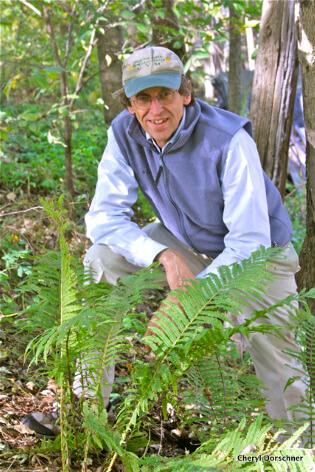Wildly popular, fiddlehead ferns fetch $8 for a small plate at tony urban restaurants, sell for up to $9 a pound at farmers’ markets and are typically ordered by chain store supermarkets in increments of 500 lbs. a week. The once lowly fronds picked along riversides, boiled and eaten as a spring tonic, have grown to “foodie” status in a world where “localvore” is a mantra.
But when David Barrington looks at a plate of these steaming green spirals, he sees an evolutionary journey that dates back to the Pleistocene, and he wonders how their increasing popularity as a food crop will ultimately affect the genetic diversity of Matteuccia struthiopteris, commonly called ostrich ferns.
Supplying the burgeoning demand, weekend pickers and full-time foragers fan out across the state typically in April when the leaves spring forth from rich loam.
John Beaulieu of Ludlow says he used to take 4-5 weeks off from his day job to pick fiddleheads. In Beaulieu’s foraging heyday 15 years ago, he’d pick a five-gallon bucketful in an hour. That’s about 30 lbs. He sold them to a produce supplier in Hartford, Connecticut who typically expected a picker to deliver 500 lbs. a week for $1-$3 a pound. “I paid for my daughter’s college by picking fiddleheads, Beaulieu says, in fact, “I paid for her wedding with fiddleheads too, so we put a little fiddlehead on the back of the invitation.”
“It’s not easy work. There are only a small group of about 20-25 people in Vermont who can harvest that kind of volume. But the demand has grown; so have the number of suppliers,” says Beaulieu, who now, at age 65, has scaled back his picking around his full-time job at Black River Produce.
An increase in the number of fiddlehead foragers is exactly what Dan Tricarico’s numbers indicate. He’s director of purchasing at Black River Produce in North Springfield. In a given season, he sees about 10 serious foragers delivering fiddleheads from the season’s start to finish and 15-20 coming once or twice. Black River Produce packages the wild vegetable in 10-lb. bags and sells them wholesale for $38-$45 each.
But more revealing, Black River’s bottom line on fiddleheads in 2013 – 4,000 lbs. – is only half of what it was in 2008. That’s not for lack of fiddleheads. “This indicates there are many more foragers and distributors now,” Tricarico concludes, “and that some foragers are selling retail in urban areas.”
HOW LONG CAN THIS LAST?
While thick carpets of M. struthiopteris seem abundant and resilient in the Green Mountain State, David Barrington, a scientist specializing in plant systematics and evolution at the University of Vermont, set out to measure whether the genetic diversity fiddlehead ferns was impacted by increasingly heavy picking. Other northeastern states and Canada support large populations of the plants as well.
Collecting data from plants in three Vermont watersheds and using molecular techniques revealed surprising results: neither of the common assumptions about its diversity is true.
“I went into this study like a good population biologist, thinking the biggest populations would be most diverse,” says Barrington. With two undergraduate students, “we tested the idea in seven locations along the Winooski and Passumpsic River watersheds.”
Back in the lab, they developed tools to reveal the DNA sequences of the plants by taking their genetic material, amplifying it, turning it out on a gel, staining it and then photographing it with an ultraviolet light camera. Once DNA sequences were in hand, they could compare plants to see whether the populations lower in the watersheds were more diverse.
But population size did not relate to diversity, it turns out.
So they tried another possibility: that the outliers – the little populations on higher ground – are independent and genetically diverse.
No. Elevation wasn’t the factor either.
“The pattern was that the Winooski populations, large or small, low or high, were consistently more diverse than those on the Passumpsic,” says Barrington. “It was geographic history not population or elevation that was significant. My guess is that the Winooski watershed on the west side of the mountains is closer to a glacial-times refuge for the fiddlehead ferns in the Mississippi valley. It was farther for the ferns to get over the mountains to the Passumpsic once the ice melted.”
The study became the honors thesis of former students Dan Koenemann and Jacqueline Maisonpierre. They and Barrington published the findings in the “American Fern Journal.”
Barrington calls the results a good demonstration of how science works, and it’s applicable to the harvesting of fiddleheads.
There’s documentation of high harvests in big river bottoms in Vermont, Maine and Quebec, Barrington points out. In Vermont, the greatest diversity is in the Winooski where the most harvesting happens. “Whether that’s a problem or not I don’t know.”
This study was a three-year, $30,000 USDA-NIFA grant through UVM’s College of Agriculture and Life Sciences. Subsequent funding makes it possible to search for genetic variation that will allow a more detailed genetic portrait of these ferns. “We have plants from Alaska, Vermont, New Brunswick – widely separated places – to see if they vary genetically. And whether the ferns genes vary by climate,” says Brendan Lyons, a senior majoring in plant biology working on this latest project.
